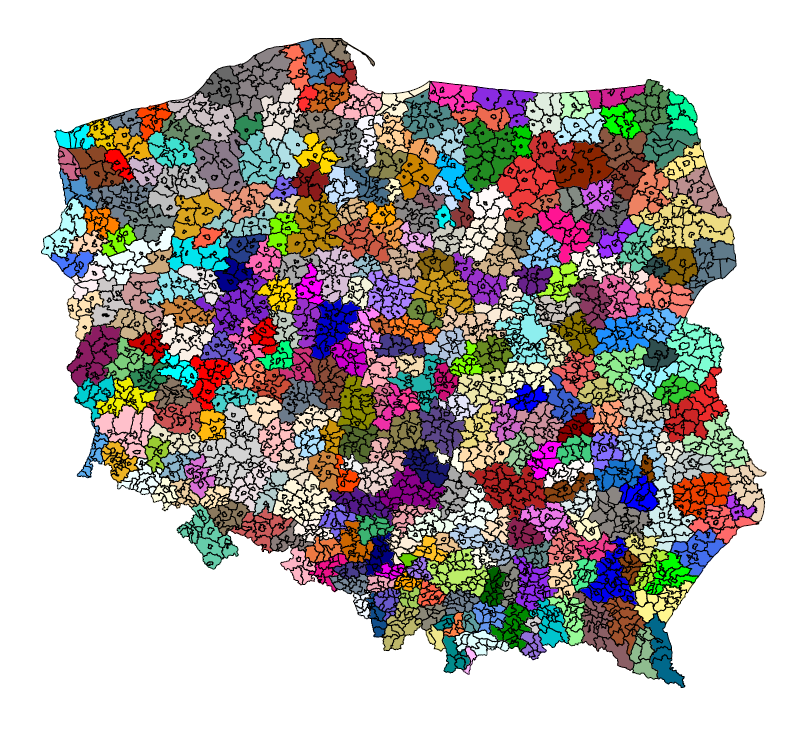Labour Market Areas in Poland
Labour Market Areas (LMAs) as the functional territories provide more precise information of phenomena on labour market. Neighbouring gminas are aggregating to LMAs, satisfying an internal cohesion and external separation principles, based on commuting flows.
In 2013 Eurostat established a Task Force on Harmonised Labour Market Areas. After over a year of work the Task Force agreed on a proposal for a harmonised methodology to define LMAs with called EU-TTWA method.
Labour Market Areas were delineated following the grant agreement No. 08141.2015.001-2015.497 on activities taken in the project entitled “Employing the EU methodology to define Labour Market Areas in Poland”. The objective of the project was to ‘support policy-making by the use of spatial information combined with social, economic and environmental statistics (08.1)’.
The activities within the scope of the project were performed by the employees of the Statistical Office in Bydgoszcz with the support of Statistical Office in Poznań and the Demographic Surveys and Labour Market Department of the Central Statistical Office.
The EU (TTWA) method operates with two properties: self-containment and number of working residents (persons employed). For both properties minimum and target values have to be defined to run the algorithm. Consequently, four parameters set the constraints to define what is considered to be an LMA:
- minimum self-containment (minSC),
- target self-containment (tarSC),
- minimum number of working residents (minSZ),
- target number of working residents (tarSZ).
The following set of parameters was chosen as the optimal in Poland:
- minSC = 0.667
- tarSC = 0.8
- minSZ = 4,000
- tarSZ = 30,000
Self‑containment (SC) is the minimal value of supply side self‑containment and the demand side self‑containment. Supply side self‑containment is the number of persons living and working in an area divided by the number of residents in the area. Demand side self‑containment is the number of persons living and working in an area divided by the number of jobs (residents and not-residents employed) in the area.
The method considers a cluster of municipalities to be an LMA if the following Condition 1 is fulfilled:

Put simply, this means that only the aggregation of gminas with a total population of 4,000 or more and at least 0.667 self-containment value can be considered as valid LMA. A group of gminas with a population of 4,000 is a Labour Market Area if at least 80 % of working residents work in this group, whereas the group of gminas with a total population of 30,000 is a Labour Market Area if at least 66,67% of working residents work in this group.
In practice the algorithm starts with assessing every gmina against Condition 1 above. If any gmina does not fulfil the condition, the gmina LAUA that gives the lowest value for the right-hand side of the condition is selected. This LAUA is then assessed against all other LAUs to find the one LAUB which has the most important commuting flows according following Formula 1:

where: ‘Commuters’ stands for the commuting flow, ‘Workers’ stands for the working residents of the gmina and ‘Jobs’ stands for the population employed in the gmina.
The LAUB is the one with the most important commuting links to LAUA. Therefore, LAUA and LAUB are grouped. The grouping of LAUA and LAUB (LAUAB) is now considered as one entity and the joined commuting flows to the other gminas will be recalculated.
Than the procedure restarts, while LAUs and groupings of LAUs (e.g. LAUAB) are equally treated.
However, in case in the ranking of gminas that do not fulfil Condition 1, a grouping of gminas gives the lowest value for the right-hand side of Condition 1, the grouping of gminas is dismembered and each gminas is re-grouped.
The process stops when all gminas or groupings of gminas fulfil Condition 1.
The last part of defining LMAs is fine tuning process. The aim of it is to provide the contiguity of Labour Market Areas. In specific cases this could lead to not fulfilling Condition 1, however such situations are acceptable due to European methodology.
Attachment LMA_2011_Poland.zip contains a file Labour Market Areas 2011.docx with a table having assignment of the gminas to their corresponding LMAs. Also shp files, which enable drawing a map of Poland with LMAs’ borders are attached.
Map situated below presents the final division for Labour Market Areas in Poland (with borders of gminas).
Map 1. Labour Market Areas in Poland in 2011 with boarders of gminas

Source: Own work.


